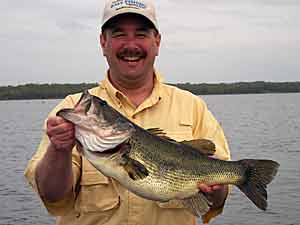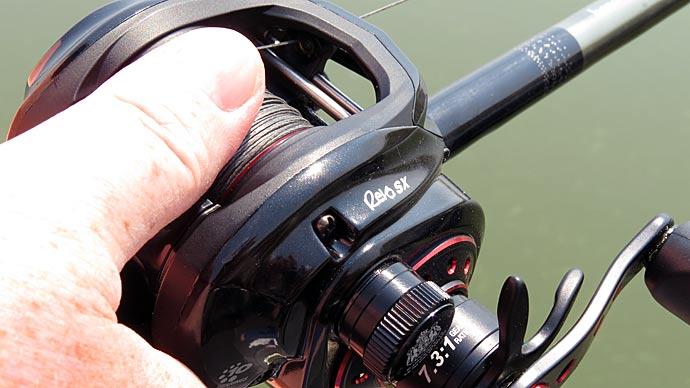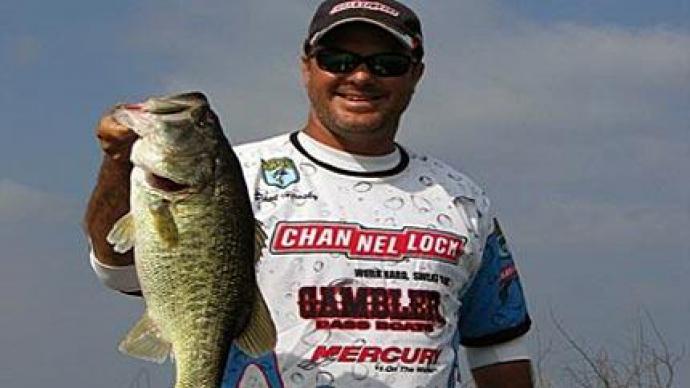
That's right! They're not just for spawning fish anymore. Lakes like Don Pedro in the Sierra Foothills have an abundance of big bass that have discovered the benefits of eating trout. She can do quite well for a big bass by eating just one trout per week. Using this knowledge, a serious trophy hunter can take advantage of their eating habits. You won't catch many fish, but the ones you hook will wear your arms out and test your equipment.
Let's first look at some tricks to making the swimbaits work for you.
I firmly believe that you need a large diameter line. The larger line will allow you to reel the heavy baits slower. Some brands of swimbaits have thick tails and won't swim properly. You need to take a pocketknife or thumbnail and take just a little bit of the plastic off just in front of the tail to relax it. This gives the tail a more realistic action; then, you can move it just as slowly as you need to.
Next, besides the spawning season, you must remember the shoreline. Get away from the bank and look for the river channels. Concentrate on those areas if you can find humps near the channel, even if they're 60 to 85 feet deep.
When kokanee are present, they tend to turn red before they spawn. Unfortunately, they will also begin to die. By using a marker and making the swimbait red to imitate a dying fish, you'll be surprised at how many big bass will fall for your offering. You need baits that are 10 to 12 inches long to be effective.
The cold winter months are my favorite times to use swimbaits because the trout are in shallower water. Every time they stock the trout, it puts out a smell track that can cover several hundred acres in no time. It takes little time for this to stir up the big bass and get them to start biting.
During this time of year, I keep several rods tied up with swimbaits. So I'll have the Osprey on one and a Basstrix on another. They all have a different purposes, and you'll have to change your approach each day. The Osprey or the Basstrix are great this time of year because they aren't fast-falling baits and are highly effective in shallow water.
Go to the main lake, near the river channel, especially if you can find a hump or rock pile, and you will hit the key targets. You should also concentrate on main lake points. I back way off and fan cast to each side of the points, counting down the bait until I reach the desired depth.
In the spring, I fish the same way but get closer to the river channel. The prespawn fish will be lined up along the edge of the river channel, waiting for a buck bass to run them up on the nest. They are also waiting for unsuspecting trout to swim by.
Stay close to the channel, along main lake points, and cast as far as possible. Feed line until you get hit or the bait gets to the bottom, then when you retrieve, drag the lure back and forth across the point until you're convinced there isn't a fish that will eat your bait. You should also look for fish along the steep rocky banks. When you find these walls, I suggest paralleling them and counting your bait down. How far down is something you should vary until you have located the depth holding fish.
When the fish are on the nest, drop the bait close by and slowly move it into the nest and hang on. Many times the huge fish will come unleashed and hammer your bait. At other times, they will try to pick up the bait by the tail and move it out of the nest. I always rig a trailer hook Osprey through the bait and into the tail. If she picks it up, she will soon be in the boat.
The best method of rigging a trailer hook is to take a high-quality treble hook, straighten one hook out, and put that into the body of the bait, far enough forward, so it doesn't inhibit the bait's action. Then, tie the treble hook with Berkley Fireline to your main hook.
Rod selection for swimbaits is crucial all year long. You will fight some big fish many times in heavy cover. I never use anything less than 25-pound test lines on a 7-foot Muskie-type rod. You'll work yourself to death trying to throw the big swim baits on a flipping stick. You need a rod that can easily handle the weight, basically a broom handle with a reel on it.
You should also use a very high-speed reel to keep up with the fish. Too often, they will pick up the bait and run right at you. You have to catch up to the fish to get a solid hookset.
If I have fish that hit the bait but don't swallow it, I know there is a big fish in the area; then I will switch to the Optimum bait - a fast-falling bait - and drag it through the area, many times enticing a vicious strike.
In a tournament situation, I'll go and get a limit of fish with a Berkley Power worm, and then I'll go out looking for that one big bite with the swim baits. If I get two bites, I will finish at the top of the list.
You won't get nearly as many bites with the swim baits, but you will get quality fish. Recently, at Lake Don Pedro, my partner and I only had three bites all day, but those three fish would have weighed approximately 30 pounds.
So, don't think that the big swimbaits are only for one time of year. You can catch trophy-sized fish all year long. Next time, we'll discuss using them in the summer and fall.
See you on the water.
Editor's note: Don Payne is a 30-year veteran of professional bass fishing and one of the nation's leading deep-water anglers. He is an excellent guide for new anglers because of his patience and teaching ability.
Reprinted with permission from Bass West Magazine




